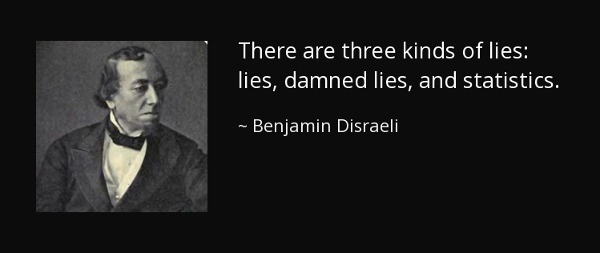I recently came across a disingenuous use of statistics to support an argument, but sadly it is one that I see on an increasingly frequent basis.
A poll was held with 2 options A or B
Option A was the most popular response, but the author supported option B
Therefore, in order to validate why Option B was the ‘right’ answer, they sub-divided the responses to A into A1, A2, A3, A4. Having created these sub-options, they then argued that option B had more support than any of the sub-option A responses, and therefore should be regarded as the valid result.
They ignored the fact that option B could equally have been divided into sub-options, and consequently these new sub-options would have not been able to attract a majority opinion either.
However, this is not a new tactic, political parties and pressure groups have been using this re-interpretation and re-classification of results to generate a mis-leading view of the statistics for many years. Even when they use apparently valid terminology like “weighting”, “re-sampling”, “corrected” this often hides the primary motive to present the data in a way that fits their agenda or pre-conceptions.
What is a cause for concern is that as people become more and more attuned to a sound-bite, easily digestible, news flash style of information presentation, they become less and less inclined to check the information being presented, or validate the claims being made – it is easier to click ‘share’ on facebook than it is to check the source for accuracy. This leads to an over-reliance on other people to supply their information, and leaves the recipient vulnerable to bias. Indeed, often when I have challenged people about the reliability of information they have shared, they expressed no idea of how to verify or check the facts for themselves – they just blindly trust that the information is right.
We are living in a world where the ability to check facts is more easy than it was say 10 years ago, yet people are showing less and less critical analysis of information being presented, and this could well lead to a new underclass of the research-poor, where the only information and knowledge they have is that which others choose to share with them, and so far more easily manipulated. Whilst many people are aware in some degree of bias in the print media, they are totally unaware of bias in digital media, assuming it is mysteriously free from the bias that they appreciate exists in more traditional forms of media.
Maybe the solution is to introduce courses in digital literacy, including how to research and fact-check information presented online. I accept that some people will for a variety of reasons opt to not avail themselves of such opportunities, but as they say “you can lead a horse to water, but you can not make it drink”. Education, of all ages and groups of society is a key to social improvement – we have campaigned to see access to education and opportunities extended to minorities over the last century, and the challenge is not done – we must continue to push for ongoing education to prevent segments of society being left behind.
